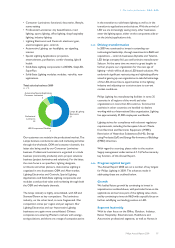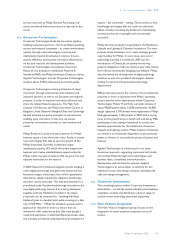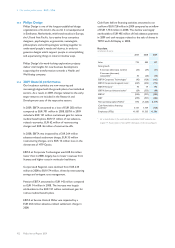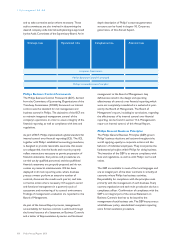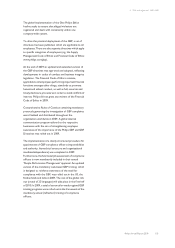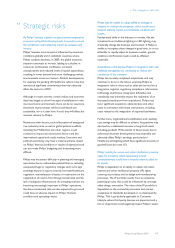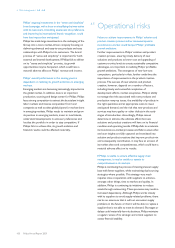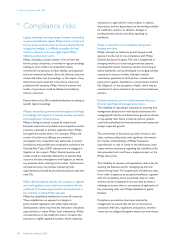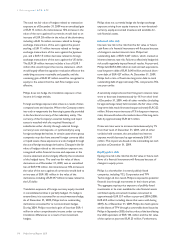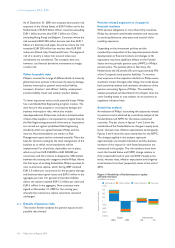Philips 2009 Annual Report Download - page 107
Download and view the complete annual report
Please find page 107 of the 2009 Philips annual report below. You can navigate through the pages in the report by either clicking on the pages listed below, or by using the keyword search tool below to find specific information within the annual report.6.4 Strategic risks
As Philips’ business is global, its operations are exposed to
economic and political developments in countries across
the world that could adversely impact its revenues and
income.
Philips’ business environment is influenced by economic
conditions globally and in individual countries where
Philips conducts business. In 2009, the global economic
situation continued to worsen, leading to a decline in
consumer and business confidence, increased
unemployment and reduced levels of capital expenditure,
resulting in lower demand and more challenging market
environments across our Sectors. Political developments,
for example the pending US Healthcare reform, have also
introduced significant uncertainties that may adversely
affect the sectors in 2010.
Although in recent months, certain indices and economic
data have began to show first signs of stabilization in the
macroeconomic environment, there can be no assurance
that these improvements will be broad-based and
sustainable, nor is it clear how, if at all, they will affect the
markets relevant to Philips.
Numerous other factors, such as fluctuation of energy and
raw material prices, as well as global political conflicts,
including the Middle East and other regions, could
continue to impact macroeconomic factors and the
international capital and credit markets. Economic and
political uncertainty may have a material adverse impact
on Philips’ financial condition or results of operations and
can also make Philips’ budgeting and forecasting more
difficult.
Philips may encounter difficulty in planning and managing
operations due to unfavorable political factors, including
unexpected legal or regulatory changes such as foreign
exchange import or export controls, increased healthcare
regulation, nationalization of assets or restrictions on the
repatriation of returns from foreign investments and the
lack of adequate infrastructure. As emerging markets are
becoming increasingly important in Philips’ operations,
the above-mentioned risks are also expected to grow and
could have an adverse impact on Philips’ financial
condition and operating results.
Philips may be unable to adapt swiftly to changes in
industry or market circumstances, which could have a
material adverse impact on its financial condition and
results.
Fundamental shifts in the industry or market, like the
transition from traditional lighting to LED lighting, may
drastically change the business environment. If Philips is
unable to recognize these changes in good time, or is too
inflexible to rapidly adjust its business models, growth
ambitions and financial results could be affected
materially.
Acquisitions could expose Philips to integration risks and
challenge management in continuing to reduce the
complexity of the company.
Philips has recently completed acquisitions, and may
continue to do so in the future, exposing Philips to
integration risks in areas such as sales and service force
integration, logistics, regulatory compliance, information
technology and finance. Integration difficulties and
complexity may adversely impact the realization of an
increased contribution from acquisitions. Philips may
incur significant acquisition, administrative and other
costs in connection with these transactions, including
costs related to the integration of acquired businesses.
Furthermore, organizational simplification and resulting
cost savings may be difficult to achieve. Acquisitions may
also lead to a substantial increase in long-lived assets,
including goodwill. Write-downs of these assets due to
unforeseen business developments may materially and
adversely affect Philips’ earnings, particularly in
Healthcare and Lighting which have significant amounts of
goodwill (see also note 15).
Philips’ inability to secure and retain intellectual property
rights for products, whilst maintaining overall
competitiveness, could have a material adverse effect on
its results.
Philips is dependent on its ability to obtain and retain
licenses and other intellectual property (IP) rights
covering its products and its design and manufacturing
processes. The IP portfolio results from an extensive
patenting process that could be influenced by, amongst
other things, innovation. The value of the IP portfolio is
dependent on the successful promotion and market
acceptance of standards developed or co-developed by
Philips. This is particularly applicable to Consumer
Lifestyle where third-party licenses are important and a
loss or impairment could negatively impact Philips’ results.
6 Risk management 6.4 - 6.4
Philips Annual Report 2009 107


